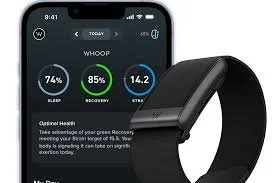More Than a Band: The Story of Whoop
Source: Whoop
Every day, we measure life in steps, calories, and notifications. Whoop asks a different question: what if we measured how well we recover? The screenless band doesn’t want attention. In the productive world we live in, Whoop offers something different. Rest as performance, recovery as data while keeping a simple design. It is not just another fitness tracker. What began as a small wrist strap has become a signal of discipline, understanding, and community.
The Struggle of Creating Change
When Will Ahmed started Whoop in 2012, he wasn’t trying to create another step counter. He wanted people to understand their bodies truly. Calories burned and miles logged are easy to measure, though recovery isn’t. The world was obsessed with screens. They were everywhere, and instant feedback was what everyone wanted.
Whoop carried a price tag of about $500 upfront that made people linger. People couldn't get over the fact that something that cost so much was so tiny and simple. The problem wasn’t just price. In a market led by Apple, Fitbit, and Garmin, Whoop had to redefine what a fitness tracker could be.
Before Whoop ever became a product, Ahmed spent years researching performance and recovery while studying at Harvard. He partnered with engineers, physiologists, and data scientists to figure out how the body measures strain, heart rate variability, and sleep quality. The team went through multiple prototypes before finding a design that could collect accurate data without bulky sensors or screens. Early versions of Whoop were tested by college athletes, who helped provide the feedback that shaped the band’s comfort, accuracy, and design.
The process wasn’t easy. There were constant challenges with battery life, comfort, and data reliability. The team had to make the band light enough to wear 24/7 while still gathering professional-level data. It took years of trial and error before they created something both useful and wearable.
The Whoop team was committed even through the backlash. Yet the people who used it, including athletes, military units, and college athletes , didn’t just like the data. They trusted it because it actually worked.
Source: Whoop
A Shift in the World
Then 2020 arrived, and the world was in panic about their health. Health mattered more than ever. Sleep, wellness, and recovery mattered more than ever before. This was Whoops calling. People noticed that changes in respiratory rate could appear before symptoms, and suddenly, trust and attention started flowing Whoops' way. It became a device that helped people feel safer, informed, and connected to what their bodies were telling them.The timing was perfect. In a moment of uncertainty, Whoop offered understanding and could measure how you felt. It moved from a simple tracker to something that felt personal and practical.
A Company Built on Restraint
Most tech brands pursue attention with bright screens and flashy marketing. Whoop chose restraint. It stayed focused on what it did best. Ahmed's team leaned into the membership model, turning Whoop from a product into a community. They were not just selling a device, they were selling a mindset. By 2021, the company had raised significant investment and reached a notable valuation of $3.6 billion. A considerable growth compared to their valuation in 2020 of $1.2 billion. For Whoop the important thing wasn't the numbers but the amount of trust the gained from there users and growth of there community
The Pulse of the Future
Today Whoop is in the middle of technology and mindfulness. It is a device that tells you when to push and when to pause and when to recover. By 2025 Whoop began connecting its data with doctors and health professionals, combining fitness and healthcare. The Healthspan features look at long term wellness and even provide hormonal insights for women, making recovery and training more personal. Higher tier memberships unlock tools like ECG readings and blood pressure tracking on the new MG model. These updates push Whoop beyond fitness. It becomes a constant health companion.
Source: Whoop
Finding Meaning in the Metrics
In today’s world, where everything feels fast and nonstop. Whoop encourages people to slow down, and take care of themselves instead of always chasing the next goal. It turns data into something more meaningful by helping people see that rest and recovery are part of success. Real progress doesn’t come from constant movement. It comes from knowing when to stop, reset, and start again stronger.
In the end Whoop is more than a fitness tracker. It represents a shift in how we think about health and we value recovery as much as effort. In a world that is in nonstop motion, Whoop tells us to remember that health and recovery are key to understanding our potential.


